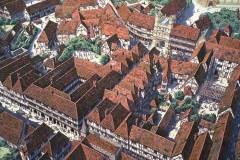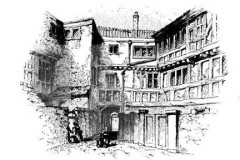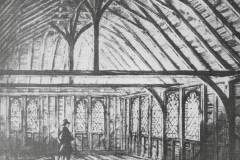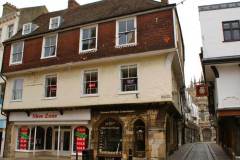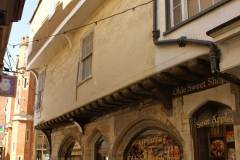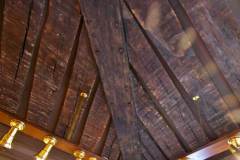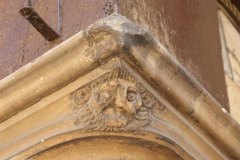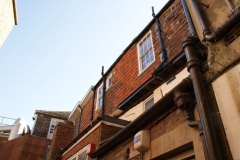High Street/Mercery Lane
Introduction
The remaining visible part of the Cheker of Hope now lies at the corner of the High Street and Mercery Lane but it was once a large inn built to accommodate pilgrims . As can be seen in the artist’s impressions (Image 1) it was a very large square three-storeyed building with a galleried central courtyard (Image 2) extending halfway along Mercery Lane.
History
The inn was built by Christchurch Priory in 1392 to accommodate pilgrims visiting the shrine of Saint Thomas Becket in the Cathedral and provide more income for the priory. The ground floor housed workshops with shop fronts with storage provided in the basement. The inn itself had first floor suites with an external gallery overlooking the courtyard (Image 2) for wealthy pilgrims and second floor dormitory under the rafters of the roof for up to 100 less wealthy pilgrims (Image 3).
The unusual name has two possible sources. The first is from the board game played at the inn on tables made of ale or beer barrels (or tuns) stood on their ends which were held together by hoops (or hopes) of iron. The second is from the Cheker building, a counting house in the Priory, referring to the counting of hopes that pilgrims felt for their visit to the shrine.
The Inn is referred to in Geoffrey Chaucer’s “The Tale of Beryn” as the resting place of the pilgrims whose stories are told in the Canterbury Tales. Much of western end of the building was destroyed in a great fire of 1865, but the facades on the High Street and Mercery Lane escaped substantially undamaged
What to see:
- The view from the High Street of the 14th century double jettied wood framed building with the upper floors refinished in stucco and painted mathematical tiles. The cathedral’s Bell Harry tower can be seen in the distance at the bottom of Mercery Lane (Image 4).
- The original stone basement and arcaded ground floor (Image 5).
- A fine example of dragon beam, a cantilevered diagonal beam supporting the corner posts of jetties above, from inside the ground floor shop (Image 6).
- A cognizance, a distinguishing badge or bearing in heraldry, said to be that of the Black Prince. A similar lion image appears on his achievements displayed above his tomb in the cathedral (Image 7).
- The jettied second floor remains of the courtyard elevation, accessible via a grey service door just along the High Street if it is open (Image 8).
Access: The building can be viewed externally at all times.
Sources; Lyle(2008); Sparks (2007); Green (1988)
SR

